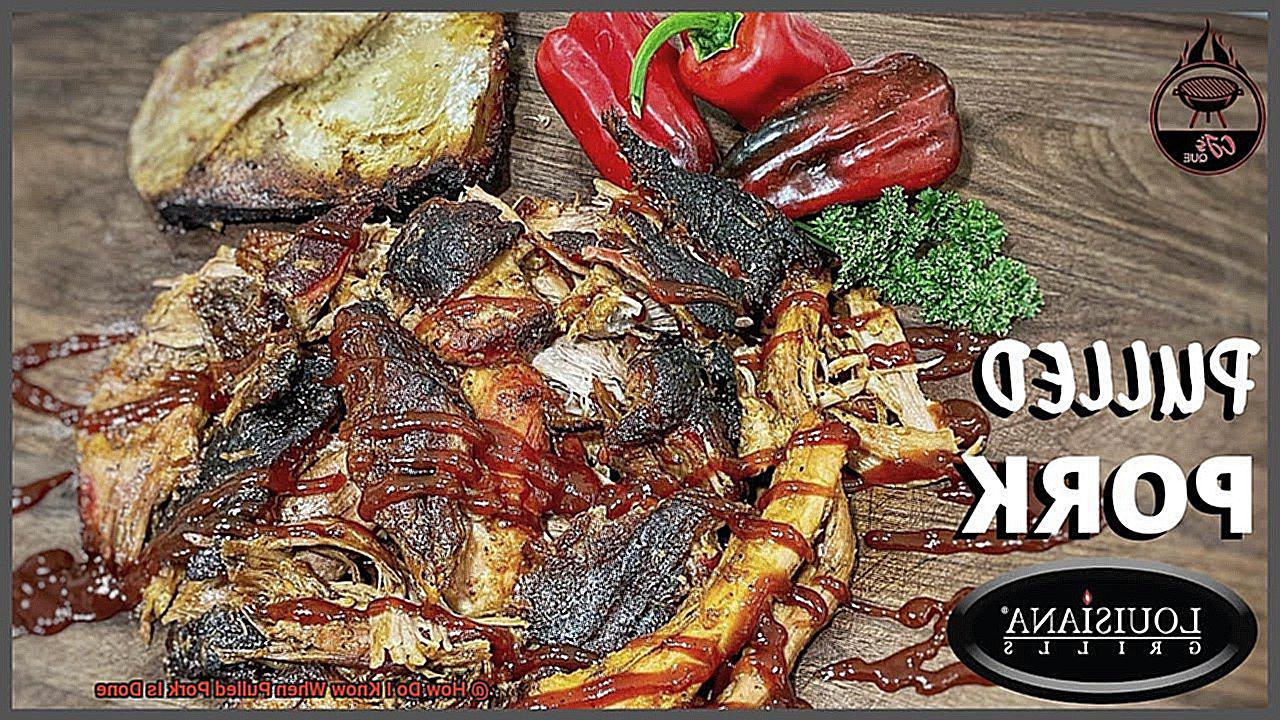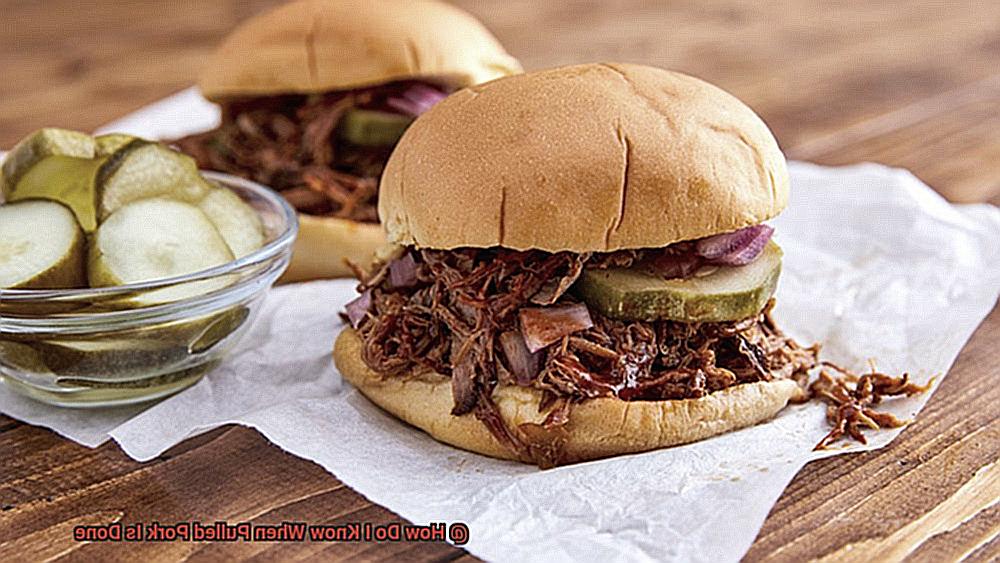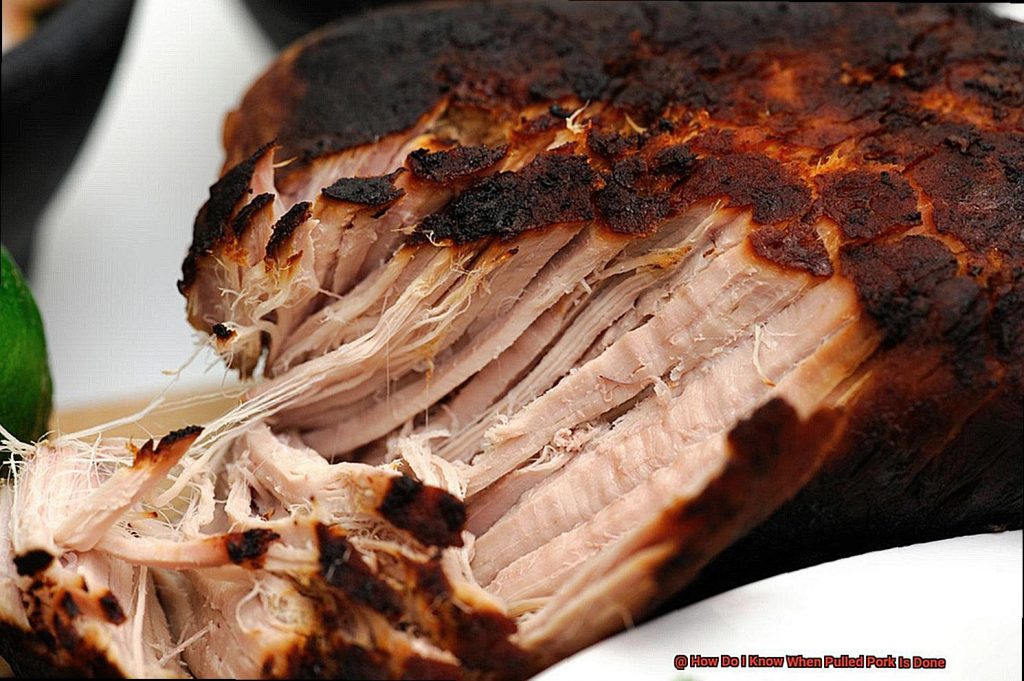Welcome to the sizzling world of pulled pork, where every bite is a flavor explosion. Whether you’re a seasoned grill master or just dipping your toes into the smoky waters, one question lingers in the back of your mind: How do you really know when your pulled pork is done?
Creating that melt-in-your-mouth pulled pork goodness isn’t just about time and patience; it’s an art form that requires a keen eye and a gentle touch. Today, we embark on a tantalizing journey, uncovering the secret signs that will lead you to pulled pork nirvana.
Get ready to be transported to a realm where succulence reigns supreme and the aroma of smoky deliciousness fills the air. Prepare to wow your friends, family, and most importantly, your taste buds as we dive into the telltale signals that signify perfection in your quest for barbecued bliss.

So grab yourself a cold drink, gather around the grill with us, and let’s set off on this mouthwatering adventure together. It’s time to demystify the process and become masters in knowing when pulled pork is truly done.
Contents
What is Pulled Pork?
Pulled pork is not just any ordinary dish – it’s a culinary masterpiece that has captured the hearts and taste buds of people all over America, particularly in the Southern states. This mouthwatering creation is the result of slow-cooking pork until it becomes tender and easily shredded, producing a meat so flavorful and juicy that it’ll leave you craving for more.
To embark on the journey of making pulled pork, you’ll need a pork shoulder or pork butt – cuts of meat that come from the shoulder region of the pig. These cuts are renowned for their marbling and rich flavor, making them ideal for slow cooking. But before the magic happens, the meat is typically seasoned with a dry rub or marinade to elevate its taste.
The cooking process for pulled pork is an art in itself. It involves low and slow cooking over an extended period of time. Picture this: your smoker, grill, or oven set to a low temperature, around 225°F (107°C), gently caressing the pork with heat for hours on end. This slow cooking allows the connective tissues in the meat to break down gradually, resulting in a tender and succulent final product. The internal temperature of the pork should reach around 195°F (90°C) to 205°F (96°C) to ensure it is fully cooked and tender.
Now comes the fun part – shredding the perfectly cooked pork. You can use two forks to pull the meat apart or get your hands on specialized meat claws for easier shredding. The end result is a pile of tantalizing shreds, ready to be mixed with barbecue sauce or other seasonings that will take its flavor profile to new heights.
The flavor explosion that awaits you with pulled pork is an experience like no other. The slow cooking process infuses the meat with smoky undertones and allows the seasonings to penetrate deeply, resulting in a harmonious blend of savory, sweet, and tangy flavors. And let’s not forget about the texture – the tender shreds of pork add a delightful melt-in-your-mouth sensation that will leave you wanting more.
The versatility of pulled pork is another reason why it has become a beloved favorite. You can enjoy it in countless ways, each one more delicious than the last. Here are just a few ideas:
- Classic Pulled Pork Sandwich: Pile the succulent shreds onto soft burger buns, generously slather them with barbecue sauce, and top it off with a side of refreshing coleslaw. The combination of the tender meat, tangy sauce, and crunchy slaw creates a symphony of flavors and textures.
- Pulled Pork Tacos: Fill warm tortillas with the juicy pulled pork, add your favorite toppings like salsa, guacamole, and cilantro, and squeeze some lime for an extra kick. The result? An explosion of flavors that will transport you to taco heaven.
- Pulled Pork Pizza: Who says you can’t have pulled pork on pizza? Spread a layer of barbecue sauce on your pizza dough, top it with the mouthwatering shreds of pork, sprinkle some cheese, and bake it until golden and bubbly. Each bite will be a flavor-packed adventure.
Different Methods of Cooking Pulled Pork
When it comes to cooking pulled pork, there are several methods that can be used to achieve mouthwatering results. From smoking to slow cooking, each technique offers its own unique flavors and textures. Let’s explore the different methods in more detail:
- Smoking: Smoking is the holy grail for achieving that authentic, smoky flavor in pulled pork. This method involves slow-cooking the pork over indirect heat for several hours. The meat absorbs the smoky flavors from wood chips or chunks, resulting in a rich and tender pulled pork. The low and slow cooking process allows the flavors to penetrate deep into the meat, creating an irresistible smoky taste that will leave you wanting more.
- Slow Cooking: Using a slow cooker or crockpot is a convenient way to cook pulled pork. Simply season the pork, place it in the slow cooker, and cook on low heat for several hours until it reaches the desired tenderness. This method requires minimal effort and ensures juicy pulled pork every time. The long cooking time allows the collagen in the meat to break down, resulting in a melt-in-your-mouth texture that is hard to resist.
- Roasting: Roasting the pork in the oven is another fantastic option for cooking pulled pork. Place the seasoned pork in a roasting pan and cook it at a low temperature for several hours. The meat becomes tender and develops a deliciously crispy exterior, adding a delightful contrast of textures to the dish. The slow roasting process allows the flavors to intensify while creating a beautiful caramelized crust on the outside of the pork.
- Grilling: Grilling is a popular method for cooking pulled pork, especially during summer cookouts. Cook the pork over direct heat using a charcoal or gas grill to achieve those beautiful grill marks and caramelized crust. Grilling adds a smoky flavor and enhances the overall taste of your pulled pork. The high heat of the grill helps to create a slightly charred and crispy exterior, while keeping the inside moist and tender.
- Sous Vide: If you’re feeling adventurous, try using the sous vide method to cook your pulled pork. Vacuum-seal the seasoned pork and cook it in a water bath at a precise temperature for an extended period. This technique ensures even and consistent cooking, resulting in incredibly tender pulled pork. The controlled temperature allows the meat to cook slowly and evenly, resulting in a perfectly cooked and succulent pulled pork.
Each cooking method has its unique advantages, from the smoky goodness of smoked pulled pork to the convenience of a slow cooker or the mouthwatering flavors of grilled pulled pork. Experiment with different techniques to discover your personal preferences in terms of flavor and texture.
Remember, regardless of the cooking method you choose, it’s important to ensure that the internal temperature of the pork reaches a safe minimum of 145°F (63°C) to prevent any risk of foodborne illnesses. Use a meat thermometer for accurate and reliable results.
The Role of a Meat Thermometer
Look no further than the unsung hero of barbecue perfection: the meat thermometer. In this comprehensive guide, we will explore the indispensable role of a meat thermometer in achieving succulent, flawlessly cooked pulled pork. From the different types of thermometers available to the optimal internal temperature range, we have all the juicy details covered. So put on your apron, ignite those grills, and let us embark on a journey to culinary greatness.
The Importance of Precision:
When it comes to pulled pork, relying solely on visual cues is a recipe for disappointment. The color or texture alone cannot guarantee ideal results—imagine dry and overcooked pork or worse, undercooked and unsafe meat. Enter the meat thermometer, your trusty sidekick that provides an accurate reading of the internal temperature for foolproof cooking.
Know Your Thermometers:
In the realm of meat thermometers, two main contenders dominate the scene: instant-read and leave-in thermometers. Instant-read thermometers offer quick temperature checks, while leave-in thermometers allow continuous monitoring throughout the cooking process. For utmost accuracy and ease of use, invest in a high-quality digital thermometer.
Unlocking Perfection – The Perfect Temperature:
To unlock the mouthwatering tenderness of pulled pork, set your sights on an internal temperature range between 195°F to 205°F (90°C to 96°C). Within this sweet spot, collagen breaks down, resulting in effortlessly shredded deliciousness. Beware of crossing this threshold, as cooking beyond it may yield dry and tough meat. Keep those digits in mind.
Mastering Technique:
Using a meat thermometer is simple yet pivotal. Insert it into the thickest part of the pork, avoiding contact with bones or fat. Take multiple readings from different areas for precise measurements. Remember, patience is key. Take the temperature towards the end of the cooking process, when you believe the pork may be done.
Rest and Relish:
Once your meat thermometer signals that the pork has reached the desired internal temperature, it’s time to remove it from the heat source. But hold your forks. Before diving in, allow the pork to rest for a few minutes. This vital step allows the juices to redistribute within the meat, resulting in a moist and flavor-packed final product.
Checking the Internal Temperature
Grilling pulled pork is no small feat. It takes time, patience, and a whole lot of love. But before you embark on this mouthwatering journey, there’s one thing you must never overlook: checking the internal temperature.
The internal temperature of your pork is the golden ticket to barbecue perfection. Forget about relying on visual cues or timing alone. Different cuts and cooking methods can throw off your timing game, so it’s crucial to get that temperature just right.
To measure the internal temperature of your pulled pork, you need a reliable meat thermometer. Don’t just stick it anywhere though. Aim for the thickest part of the meat, away from any bone or fat. Hitting those areas can lead to inaccurate readings, and we don’t want that. Look for that sweet spot between 195°F to 205°F (90°C to 96°C) for melt-in-your-mouth tenderness.
Now, here’s a pro tip you don’t want to miss: take your pork off the grill or smoker when it hits around 190°F (88°C). Why? Because even after you remove it from the heat, the pork keeps cooking. By giving it a good rest for at least 15-20 minutes, the juices will redistribute, resulting in an incredibly tender and flavorful end product.
But what if you’re flying without a meat thermometer? Fear not, my friend. You can still check for doneness by pulling the meat apart with two forks. If it effortlessly shreds apart and has a delicate texture, chances are it’s done. However, keep in mind that this method isn’t as precise as using a thermometer.
Testing the Tenderness
Grilling pulled pork is an exciting culinary journey that demands attention to detail, particularly when it comes to achieving the ideal tenderness. To ensure your pulled pork is juicy and bursting with flavor, it’s crucial to know how to test its tenderness. In this article, we will explore a range of methods to accurately assess the tenderness of pulled pork, empowering you to confidently grill a mouthwatering masterpiece.

The Meat Thermometer Method:
Your trusty companion in testing the tenderness of pulled pork is the meat thermometer. Insert it into the thickest part of the meat, avoiding any bones. Aim for an internal temperature between 195°F and 205°F (90°C and 96°C). Within this range, the collagen in the meat breaks down, resulting in succulent and easily shredded pork.
The “Fall-off-the-Bone” Test:
This method isn’t limited to ribs – it works wonders for pulled pork. Grab a pair of tongs and gently tug on a piece of meat. If it effortlessly separates from the rest and falls off the bone with minimal effort, your pork is perfectly tender and ready to be devoured.
Visual Cues:
Keep a watchful eye on your pork as it cooks. Look for a beautiful golden brown crust known as “bark.” This caramelized exterior adds an extra layer of flavor to your pulled pork. Additionally, observe any signs of rendered fat on the surface of the meat. A fully cooked piece of pulled pork should have melted fat, leaving behind moist and succulent meat.
The Touch Test:
As your pork cooks, it becomes progressively softer and more yielding to the touch. With heat-resistant gloves or tongs, gently press the meat to check its firmness. When done, it should feel tender and give way easily under slight pressure. Be cautious not to overcook, as this can make the meat mushy and compromise its desired texture.
Judging by Appearance
Judging pulled pork by appearance is a skill that separates the masters of the grill from the novices. Achieving mouthwatering perfection hinges on visual cues that reveal the secrets of a well-cooked masterpiece.
First and foremost, feast your eyes on the outer layer of the pork. The aim is a dark, caramelized crust that adds incredible flavor. This beautiful crust should boast a deep brown color, with just the right amount of crispiness that tantalizes the taste buds without veering into burnt territory.
Another clue lies in the meat’s shrinkage. When fully cooked, pulled pork will gracefully contract, with its edges elegantly pulling away from the bone or fat cap. This visual indicator signals that your pork is inching closer to perfection.
And what about tenderness? The meat should be so tender that it surrenders effortlessly to a fork or tongs. If it resists your attempts to pull it apart, it yearns for more time on the grill.
But hold on. Don’t disregard the internal temperature. To reach optimal tenderness, the pork’s internal temperature should hover around 195°F (90°C) to 205°F (96°C). A trusty meat thermometer can help you discern this sweet spot when inserted into the thickest part of the meat. Remember, finding this balance is key to avoid ending up with dry and tough pulled pork.
Variables that Affect Cooking Time
Embarking on a culinary journey to create mouthwatering pulled pork is an adventure that promises a symphony of flavors tantalizing your taste buds. However, the path to perfection requires an understanding of the variables that can influence the cooking time of this delectable dish. So, before igniting those coals and preparing the meat thermometer, let’s dive into the science behind achieving the ideal pulled pork texture and flavor.
Cooking Method:
The chosen cooking method plays a significant role in determining cooking time. Slow cookers and crockpots, with their lower temperatures, require more time to break down the tough fibers in the meat. Conversely, grilling or oven-roasting at higher temperatures can expedite the cooking process.
Size of the Pork:
Size matters when it comes to pulled pork. Larger roasts necessitate more cooking time to ensure thorough doneness. To guarantee even cooking, aim for uniform thickness throughout your pork roast.
Starting Temperature:
Avoid shocking your pork by placing it straight from the fridge onto the grill. Allowing it to reach room temperature before cooking ensures more even heat distribution and reduces overall cooking time.
Cooking Temperature:
The temperature at which you cook your pulled pork is paramount. Lower temperatures around 225°F (107°C) yield tender, flavorful results but entail a longer cooking time. Higher temperatures like 325°F (163°C) will shorten cooking time but may compromise tenderness.
Bone-in vs Boneless:
If using a bone-in roast, be prepared for a slightly longer cooking time. Bones act as insulators, slowing down heat transfer. In contrast, boneless roasts cook more quickly due to unhindered heat distribution.
Meat Marination:
Marinating adds depth of flavor but can also impact cooking time. Longer marination times may introduce moisture to the meat, potentially increasing cooking time. Strike a balance between flavor enhancement and timely cooking.
Oven or Grill Temperature Fluctuations:
Maintaining consistent and even temperatures throughout the cooking process is crucial for achieving perfectly cooked pulled pork. Vigilance is required to adjust heat sources as needed, avoiding the perils of undercooking or overcooking.
Conclusion
In conclusion, determining the perfect moment when pulled pork is done is an art that combines multiple factors. The cooking method, internal temperature, tenderness, appearance, and a variety of variables all play a role in this culinary masterpiece. However, the internal temperature stands as the ultimate indicator of success. Aim for a mouthwatering range of 195°F to 205°F (90°C to 96°C) to achieve that melt-in-your-mouth tenderness we all crave. Don’t forget the indispensable tool: a reliable meat thermometer that will lead you straight to perfection.
Assessing tenderness can be an adventure in itself. Try the “fall-off-the-bone” test or simply use your fingertips to gauge its readiness. Look out for visual cues too – a dark caramelized crust and noticeable shrinkage from the bone or fat cap are signs that your pulled pork is on its way to becoming extraordinary.
Be prepared for surprises along the way as various variables come into play. The cooking method, size of the pork, starting temperature, cooking temperature, bone-in versus boneless cuts, meat marination – each element has a say in how long it takes to reach nirvana. Stay vigilant and make adjustments accordingly.
Remember, achieving succulent and flavorful pulled pork requires dedication and experimentation. With practice comes mastery in knowing when your creation is truly complete.






